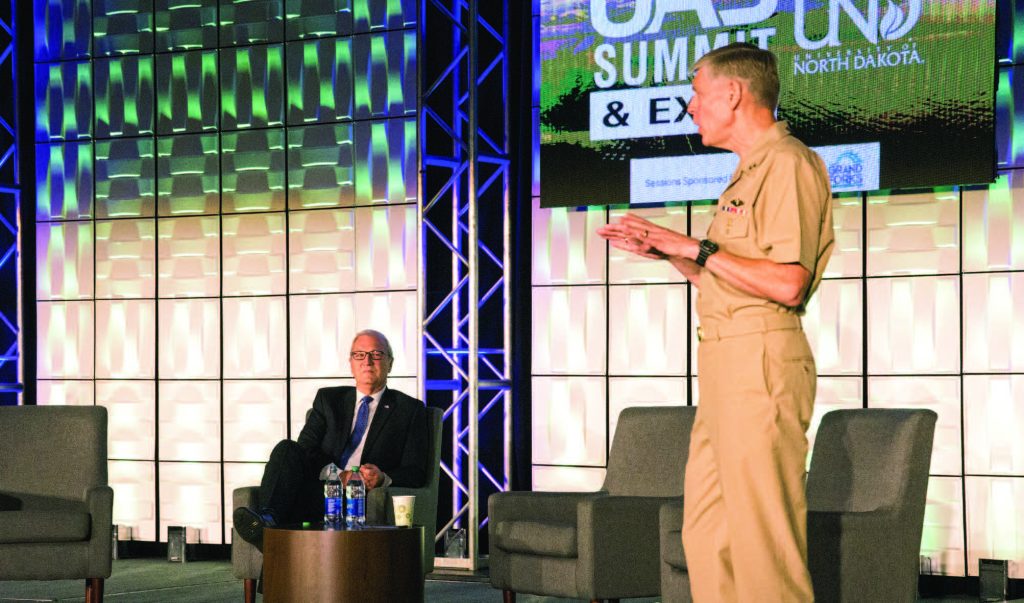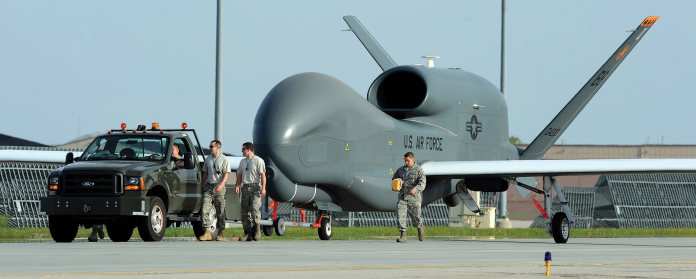North Dakota has played a critical part in deterring our adversaries since the beginning of the Cold War. The Soviet Union always knew North-Dakota-based bombers, radars and intercontinental ballistic missiles were cutting edge and ready to deter Communist aggression. While many of these weapons still deter our peer adversaries today, times have changed and so have the threats. In response, North Dakota continues to play a leading role as we modernize our nuclear deterrence and develop Unmanned Aerial Systems (UAS) to face off against surging adversaries, such as China.
In October, I had the pleasure of speaking at the 15th annual UAS Summit & Expo in Grand Forks, where I highlighted this race for military technology and the rapidity at which this technology is growing, which I begrudgingly call “the speed of China.” Unfortunately, China has passed us in the speed it takes to turn an idea (many times stolen) into a weapon, matching or exceeding our own.
A perfect example is the recent Chinese hypersonic weapons test. After being launched into orbit, a Chinese spacecraft, capable of carrying nuclear weapons, circumnavigated the globe at five times or more the speed of sound. Before reentry, according to news reports, the maneuverable glide vehicle fired one and perhaps two missiles while zooming high above the South China Sea—a remarkable engineering feat that surprised Pentagon scientists. Demonstrations like this are the reason why China should be considered no less than a peer adversary, and why we need to aggressively avoid being downgraded to a near-peer competitor.
So how do we respond to this kind of technological growth from our adversaries?
The short answer is the creation of an ecosystem that allows the technology to grow in as many directions as possible. The longer answer involves working with local, state and federal governments, as well as any and all regulatory branches, including the military, private sector, universities and anyone else who wants to participate. All these forces working in tandem enable technology to grow. This is by no means easy, but North Dakota has been making significant strides in developing a more encompassing UAS ecosystem.
North Dakota is blessed to have a population with expertise in operating UAS. Our Fargo Air National Guard started flying MQ-1 Predators and then MQ-9 Reapers in 2007, while Grand Forks Air Force Base started flying RQ-4 Global Hawks in 2011. The experience our airmen gained from operating critical missions around the world brought a sophisticated level of understanding of exactly how to effectively operate UAS—underscoring how valuable UAS technology is to the warfighter. This knowledge and experience will feed future growth.
With our Midwest work ethic and forward-thinking tendencies, the North Dakota Department of Commerce set up the Northern Plains UAS Test Site in 2013, as one of seven such sites nationwide designated by the Federal Aviation Administration (FAA). With state funding and the FAA’s regulatory assistance, the test site has grown to include Beyond Visual Line of Sight (BVLOS) command links, which allow UAS to be flown far from their operators within identified sectors of the state. With FAA and Federal Communications Commission assistance, we hope to expand this statewide. North Dakota’s accommodating environment, backed by federal agencies and the state’s government, feeds growth.
With the local expertise of the military UAS base in Grand Forks, a positive vector for permissive regulations, available space adjacent to the base with access to the runway and detect-and-avoid radar capability, a partnership was formed with the U.S. Air Force, the County of Grand Forks and Grand Sky Development Company, LLC. This partnership created Grand Sky, the nation’s first commercial UAS business and aviation park. Grand Sky now houses industry leaders, such as Northrop Grumman and General Atomics, which execute thousands of hours of training and testing for UAS in North Dakota airspace. These opportunities—from employment to runway access and airspace to BVLOS command links—all lead to expansion.
It’s important to underscore the importance of having the UAS testing options North Dakota provides to companies and the military alike. For a technology or a capability to grow fast, it needs to be tested, possibly fail, and then be fixed and tested again. But options for UAS testing within the United States are very limited and often restricted to military ranges with busy schedules and other competing priorities. Additional delays often occur because companies work longer to lower risk before getting their limited chances to test. However, increasing opportunities for testing, as we’re doing in North Dakota, means the technology can come off the drawing board quicker and advance to a proven system faster than our current process allows.
Institutions of higher education are also critical to development. In addition to the University of North Dakota’s (UND) long history of teaching young men and women to fly, the university has been at the forefront of UAS growth for more than a decade. UND created the Research Institute for Autonomous Systems (RIAS), whose mission statement says it all: “Create new autonomous systems through multidisciplinary research and lead development of world-changing autonomous policies, with the goal of driving a vibrant, diverse and sustainable economy consistent with ethical and legal standards.” RIAS’s and UND’s efforts have grown the talent base and incubated the innovation that feed growth.
And talent attracts talent, which is why North Dakota has been the destination for several distinguished visitors in the fields of science, technology and national defense. Recent visits by visionaries and leaders include NASA Administrator Jim Bridenstine; Chief of Space Operations, U.S. Space Force, General Jay Raymond; Director of the Space Development Agency Derek Tournear, PhD; Secretary of the Air Force Frank Kendall; Air Force Chief of Staff General Charles Brown Jr.; and Chief of Naval Research Rear Admiral Lorin Selby, to name a few. These visits precipitate knowledge exchanges, which wouldn’t happen without the draw of North Dakota’s UAS ecosystem.

These are just a few examples of the reason why North Dakota has been recognized by the Mercatus Center at George Mason University as the number one state for UAS readiness. I could go on about the growth of space capabilities, both at our military bases and UND, and how this is directly tied into how we’ll operate UAS. Or how the Range Hawk UAS capability, which is being developed at Grand Sky, will help test future hypersonic capabilities. Or how having permissive airspace for UAS is perfect for testing counter-UAS capabilities. Or how the Customs and Border Protection agency uses North Dakota’s UAS ecosystem to train its UAS pilots. Or how none of this would be possible without the vision, support of and acceptance by the great people of North Dakota. Or Congressional leadership from the likes of U.S. Senator John Hoeven, which dates back to his days as governor, to establish North Dakota as a UAS hub positions North Dakota for success.
Ultimately, if we are going to keep up with China, the U.S. will have to build off North Dakota’s success story. What we are doing will have a substantial effect on how we keep up with China and the rest of the world when it comes to UAS technology. And, North Dakota is setting the example for how other technologies need to grow.
In addition to the University of North Dakota’s long history of teaching young men and women to fly, the university has been at the forefront of UAS growth for more than a decade.
The Honorable Kevin Cramer
The Honorable Kevin Cramer was elected to the U.S. Senate on November 6, 2018 after serving three terms as North Dakota’s At-Large Member of the U.S. House of Representatives. He is the first Republican to hold this Senate seat in his lifetime. He serves on the Armed Services, Environment and Public Works, Veterans Affairs, Banking, Housing and Urban Affairs and Budget Committees. Cramer served on the North Dakota Public Service Commission from 2003 to 2012. During this time, he helped oversee the most dynamic economy in the nation. He worked to ensure North Dakotans enjoy some of the lowest utility rates in the United States, enhancing their competitive position in the global marketplace. Cramer earned a BA from Concordia College and a Master’s in Management from the University of Mary. On May 4, 2013, Cramer was conferred the degree of Doctor of Leadership, honoris causa, by the University of Mary.

